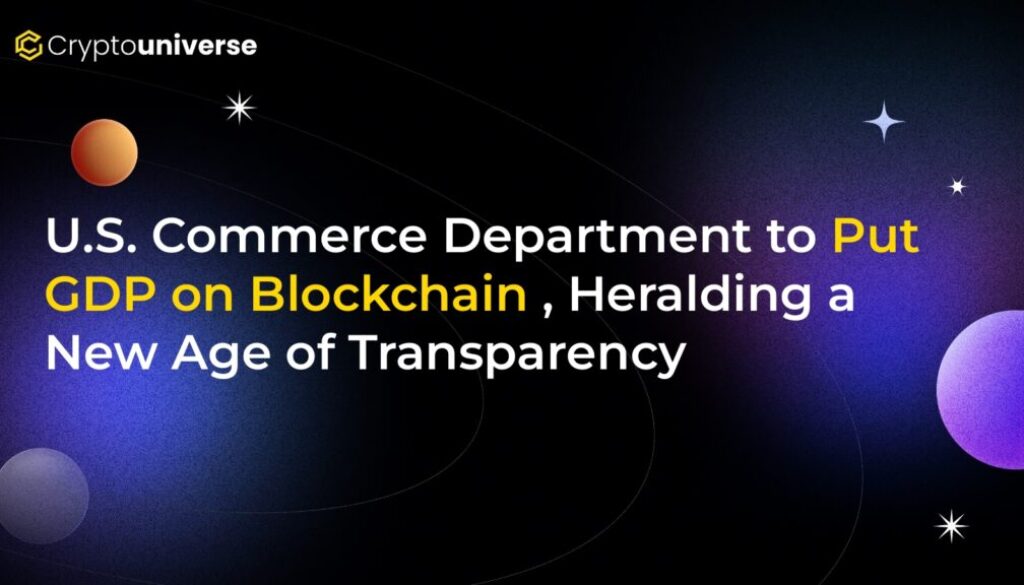U.S. Commerce Department to Put GDP on Blockchain, Heralding a New Age of Transparency

A Landmark Move for Government Data
In a move signaling a major shift in how official government statistics are handled, the United States is set to embrace blockchain technology for its most critical economic data. Commerce Secretary Howard Lutnick announced that the Department of Commerce will begin publishing key economic figures, starting with the Gross Domestic Product (GDP), directly on a blockchain.
The announcement, made during a cabinet meeting in Washington, positions the U.S. at the forefront of governmental blockchain adoption and aligns with a broader pro-technology agenda. This initiative promises to bring unprecedented transparency and security to data that drives global markets and policy decisions.
The Announcement: From Washington to the Blockchain
Addressing President Donald Trump and other officials, Secretary Lutnick laid out the administration’s vision for a more technologically advanced and transparent government. His statement underscored the political significance of the move.
“The Department of Commerce is going to start issuing its statistics on the blockchain, because you are the crypto president, and we are going to put our GDP on the blockchain so people can use it for data and distribution,” Lutnick stated.
Initially, the focus will be on the quarterly GDP releases, a cornerstone of economic analysis. Once the technical framework is established and proven, this model could be extended to other government agencies and datasets, fundamentally changing the landscape of public data distribution.
Why This Is a Game-Changer for Transparency and Trust
Moving official statistics to a distributed ledger is more than just a technical upgrade; it’s a fundamental improvement in how data is shared and trusted. Here’s why the decision for the U.S. to U.S. Commerce Department to
- Immutable and Tamper-Proof: Once data is recorded on a blockchain, it cannot be altered or deleted. This creates a permanent, verifiable record of economic figures, eliminating concerns about data manipulation or retroactive revisions not being tracked.
- Unprecedented Transparency: A public blockchain allows anyone, anywhere, to view and verify the data. This removes the reliance on a single government portal, fostering greater public trust in official statistics.
- Enhanced Accessibility and Automation: Developers, researchers, and financial institutions can directly access this on-chain data to power applications, fuel financial models, and even automate smart contracts that rely on economic indicators. This opens up a new world of possibilities for DeFi and data analytics.
- A Powerful Signal for Adoption: When the world’s largest economy uses blockchain for a function as critical as GDP reporting, it serves as a massive validation of the technology’s real-world utility beyond speculative assets.
The “Crypto President” and a Pro-Technology Stance
This initiative is deeply intertwined with the administration’s vocal support for digital assets. Secretary Lutnick’s reference to President Trump as the “crypto president” was a clear nod to this stance. In a recent post on X (formerly Twitter), Lutnick reinforced this vision:
“Technology is at the foundation of the Trump presidency. This Administration is going to use Bitcoin, digital assets, and blockchain to drive America forward and remain the leader in the global economy.”
This move is a tangible step toward fulfilling that promise, demonstrating a commitment to leveraging cutting-edge technology to modernize government functions.
Is the U.S. Playing Catch-Up? A Look at Global Adoption
While this is a historic first for U.S. federal economic reporting, other governments and jurisdictions have already been experimenting with distributed ledger technology:
- The European Union launched its European Blockchain Services Infrastructure (EBSI) back in 2018 to deliver cross-border public services.
- In 2021, Singapore and Australia collaborated on a project to test blockchain for seamless trade documentation.
- More recently, California’s DMV moved 42 million vehicle titles onto the Avalanche blockchain in 2024 to combat fraud and streamline processes.
The Commerce Department’s initiative, therefore, can be seen as a crucial step for the U.S. to assert its leadership and keep pace in a world increasingly integrating blockchain into public infrastructure.
What’s Next? The Road to On-Chain Economics
While the announcement has generated significant excitement, key details are still being finalized. Questions remain about which blockchain will be used—a private, permissioned ledger or a public one—and the specific technical mechanisms for publishing the data. Lutnick acknowledged they are still “ironing out the details.”
Regardless of the specifics, this decision marks a pivotal moment. It lays the groundwork for a future where public data is not just published but is verifiably true, instantly accessible, and programmatically useful. The era of on-chain economic data has officially begun in the United States, and the world will be watching closely.


